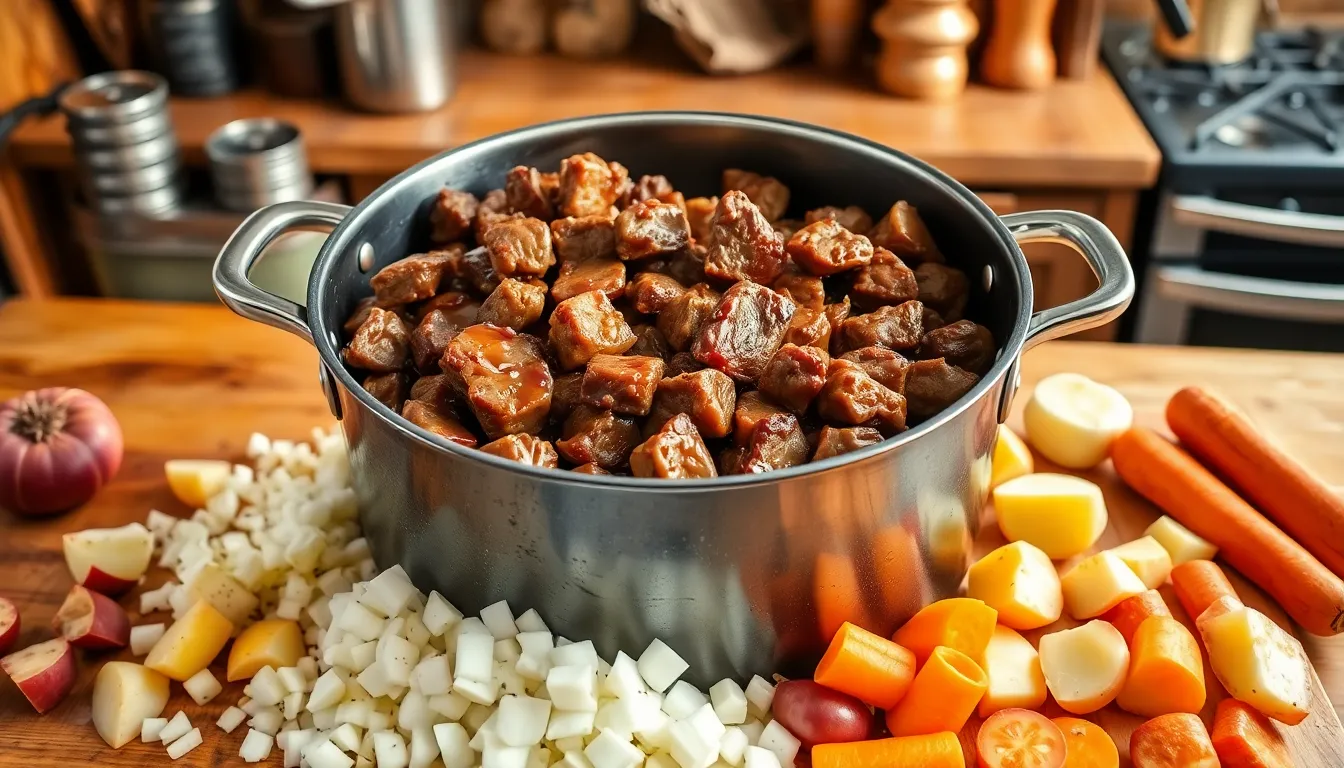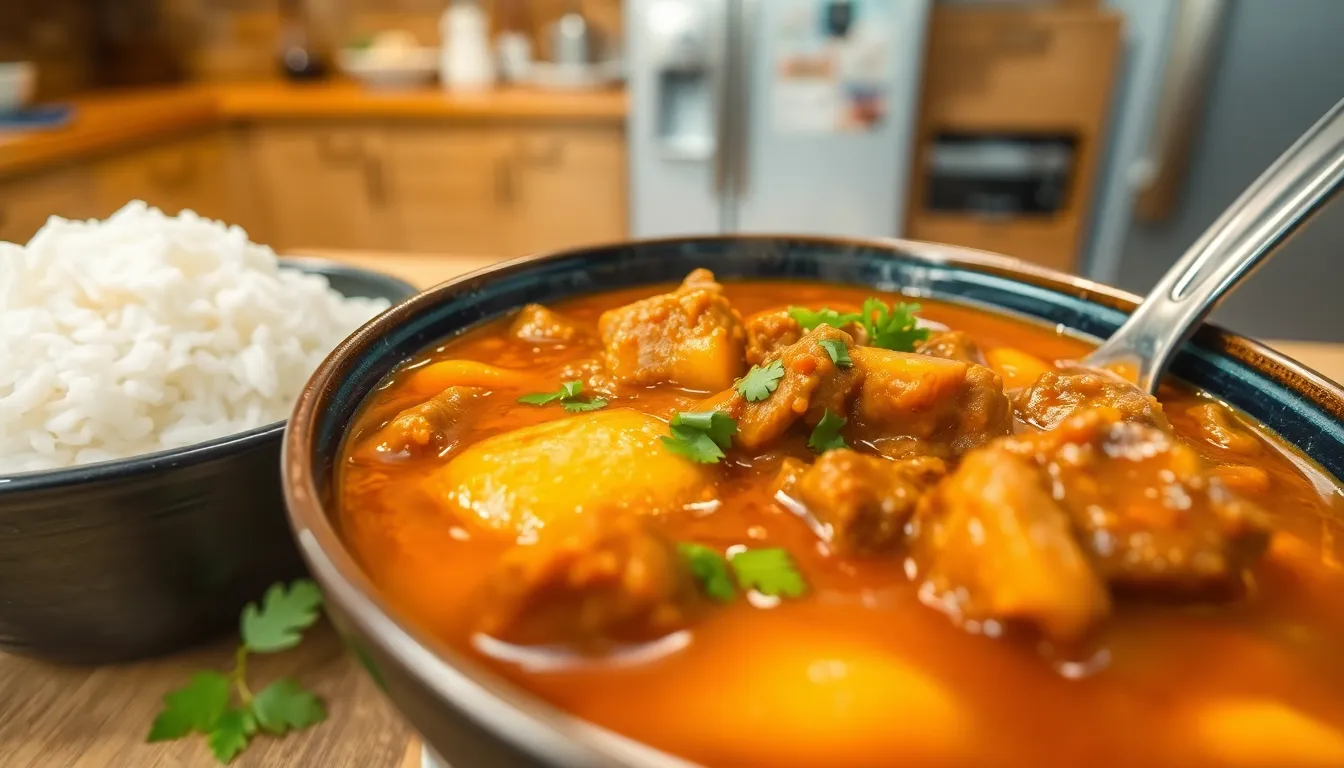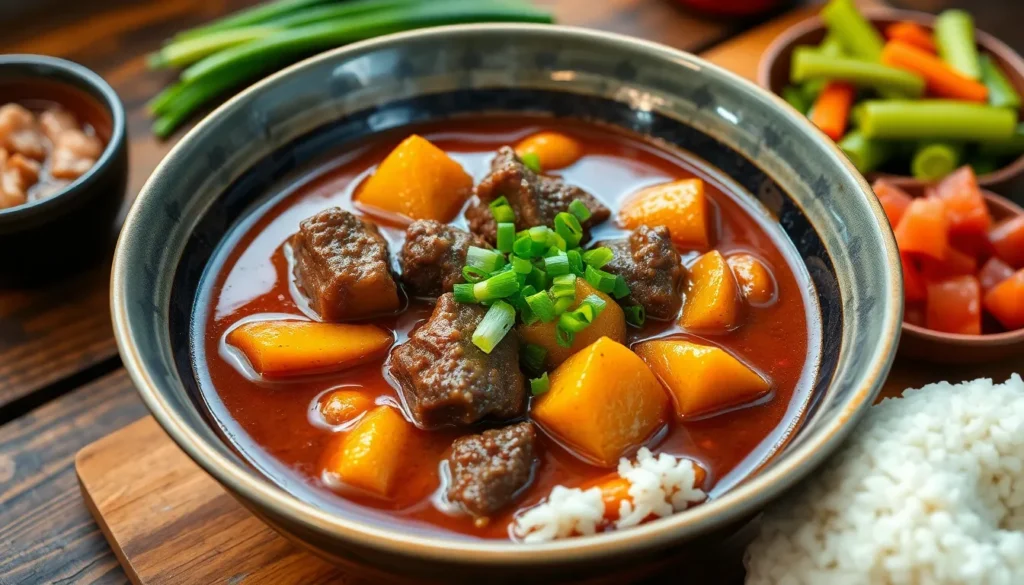We’ve fallen head over heels for Japanese curry’s unique charm – it’s sweeter and milder than its Indian counterpart yet packed with incredible depth. This comforting dish became a household staple in Japan during the Meiji era and has since won hearts worldwide with its rich, velvety sauce that clings perfectly to tender beef chunks.
What sets Japanese curry apart is its approachable flavor profile that appeals to all ages. The roux-based sauce combines aromatic spices with a hint of sweetness that creates an irresistible umami experience. Unlike fiery curries you might expect this golden-brown beauty offers warmth without overwhelming heat.
Our Japanese beef curry recipe delivers restaurant-quality results in your own kitchen. We’ll show you how to achieve that signature thick consistency and develop those complex flavors that make this dish so addictive. Get ready to discover why millions of families across Japan consider this their ultimate comfort food.
Ingredients
Creating authentic Japanese beef curry requires quality ingredients that build layers of flavor. We’ve organized our ingredient list by preparation stage to streamline your cooking process.
For the Curry Base
- 4 tablespoons vegetable oil (divided)
- 3 tablespoons all-purpose flour
- 2 tablespoons curry powder
- 1 teaspoon garam masala
- 4 cups beef stock (low-sodium preferred)
- 2 tablespoons soy sauce
- 2 tablespoons Worcestershire sauce
- 1 tablespoon ketchup
- 1 tablespoon honey
- 1 bay leaf
- 1/2 teaspoon salt (adjust to taste)
- 1/4 teaspoon black pepper
For the Beef and Vegetables
- 2 pounds beef chuck roast (cut into 2-inch cubes)
- 2 large yellow onions (sliced thick)
- 3 medium carrots (cut into 1-inch diagonal pieces)
- 4 medium potatoes (peeled and cut into 2-inch chunks)
- 3 cloves garlic (minced)
- 1 tablespoon fresh ginger (grated)
- 2 tablespoons vegetable oil (for browning beef)
Optional Garnishes
- 4 cups cooked Japanese short-grain rice
- 2 green onions (thinly sliced)
- Japanese pickled vegetables (fukujinzuke)
- Hard-boiled eggs (halved)
- Fresh cilantro leaves
Equipment Needed

Creating authentic Japanese beef curry requires the right tools to achieve that signature velvety texture and deep flavor. We recommend gathering these essential pieces of equipment before starting your cooking journey.
Large Dutch Oven or Heavy-Bottomed Pot
A Dutch oven serves as the foundation for slow simmering and braising your beef until tender. The heavy bottom distributes heat evenly and prevents burning while the thick walls retain heat for consistent cooking temperatures. We prefer a 5-6 quart capacity to accommodate all ingredients comfortably.
Sharp Chef’s Knife and Cutting Board
Precise knife work makes a important difference in cooking times and final texture. Your chef’s knife will handle cutting beef chuck roast into uniform chunks and dicing vegetables to consistent sizes. A sturdy cutting board provides a stable work surface for safe preparation.
Wooden Spoon or Heat-Resistant Spatula
Stirring and deglazing require tools that won’t scratch your pot’s surface. Wooden spoons work exceptionally well for scraping up those flavorful browned bits that develop during the searing process. These utensils also handle high heat without melting or warping.
Measuring Cups and Spoons
Accuracy in measuring curry powder, liquids, and seasonings ensures consistent results every time. We recommend having both dry and liquid measuring cups available, plus a complete set of measuring spoons for smaller quantities like garam masala and honey.
Rice Cooker or Medium Saucepan
Japanese short-grain rice serves as the traditional accompaniment to beef curry. A rice cooker delivers perfectly steamed rice with minimal effort, though a medium saucepan with a tight-fitting lid works equally well for those who prefer stovetop cooking.
Having these tools ready streamlines your cooking process and helps you achieve that restaurant-quality Japanese beef curry we’re aiming for.
Prep Instructions

Proper preparation is the foundation of exceptional Japanese beef curry. We’ll guide you through each critical step to ensure tender beef and perfectly cooked vegetables in our rich curry sauce.
Preparing the Beef
We recommend using beef chuck roast for this recipe because it becomes incredibly tender and succulent after slow cooking. Cut the beef into 2-inch chunks to ensure even cooking throughout. Season each piece generously with salt and pepper before browning.
Heat oil in a large pot over medium-high heat until it shimmers. Brown the beef chunks on all sides to develop deep flavor and create those essential caramelized bits on the bottom of the pot. This step typically takes 6-8 minutes total. Once browned, remove the beef from the pot and set it aside while we prepare the vegetables.
Preparing the Vegetables
Chop your onions, potatoes, and carrots into large chunks that will hold their shape during the long cooking process. We also recommend adding mushrooms if you enjoy their earthy flavor. Keep the vegetable pieces roughly the same size for uniform cooking.
Using the same pot where we browned the beef, sauté the onions until they turn golden and fragrant. The fond left from browning the beef will add incredible depth to our curry base. Add the minced garlic and ginger to the pot and sauté for an additional 2-3 minutes until aromatic.
Making the Roux
Japanese curry relies on curry roux for its signature thick consistency and complex flavor profile. We can use pre-made Japanese curry roux such as S&B Golden Curry, which contains a perfectly balanced blend of spices and thickening agents. Break the roux into individual cubes for easier dissolution.
For those preferring homemade roux, combine flour, butter, and Japanese curry powder in a separate pan over medium heat. Cook while stirring constantly until the mixture becomes fragrant and slightly darkened. Whether using store-bought or homemade roux, we’ll add it to our curry after the beef and vegetables have simmered until tender.
Cooking Instructions

Now we’ll transform our prepared ingredients into a rich and flavorful Japanese beef curry through three essential stages. Each step builds upon the previous one to create layers of deep umami flavor.
Searing the Beef
We begin by heating 2 tablespoons of vegetable oil in our large Dutch oven over medium-high heat. Season the beef chuck chunks generously with salt and black pepper before adding them to the hot oil. We sear each piece for 2-3 minutes per side until all surfaces develop a deep golden-brown crust.
The browning process creates fond on the bottom of the pot which adds incredible depth to our curry base. Remove the seared beef to a plate and set aside while we build our aromatic foundation. We keep the rendered fat and browned bits in the pot as they contain concentrated beef flavor.
Building the Curry Base
Using the same pot with the remaining beef fat we sauté the chopped onions over medium heat for 8-10 minutes until they turn golden brown and caramelized. Add the minced garlic and ginger to the onions and cook for another 30 seconds until fragrant.
We return the seared beef to the pot along with any accumulated juices. Pour in 4 cups of beef stock ensuring the liquid just covers the ingredients. Add the bay leaf and bring the mixture to a gentle simmer over medium-low heat.
Cover the pot partially and let the beef simmer for 1.5 to 2 hours stirring occasionally and adding more stock if needed. The beef reaches perfect tenderness when it easily breaks apart with a fork.
Simmering and Final Assembly
Once our beef achieves melt-in-your-mouth texture we add the chunked potatoes and carrots to the pot. Cover completely and simmer for an additional 15-20 minutes until the vegetables pierce easily with a knife but still hold their shape.
We turn off the heat before adding our curry roux blocks to prevent scorching. Break the roux into smaller pieces and dissolve each piece in a ladle of hot cooking liquid before stirring it back into the pot. Add the soy sauce Worcestershire sauce ketchup and honey at this stage.
Return the pot to low heat and simmer uncovered for 3-5 minutes while stirring frequently. The curry reaches perfect consistency when it coats the back of a spoon and no longer appears watery. We adjust the thickness by adding water if too thick or simmering longer if too thin.
Serving Suggestions

We recommend serving Japanese beef curry over steamed Japanese short-grain rice to create an authentic dining experience. The sticky texture of this rice variety perfectly complements the rich curry sauce and helps balance the bold flavors.
Traditional accompaniments elevate the meal significantly. We suggest pairing the curry with pickled vegetables like Fukujinzuke or Rakkyo (pickled shallots) to add tangy contrast to the savory richness. These pickled elements cut through the curry’s velvety texture while providing a refreshing palate cleanser between bites.
Fresh garnishes bring visual appeal and additional flavor dimensions to your dish. We recommend sprinkling chopped green onions across the top for a mild onion flavor and vibrant color contrast. Hard-boiled eggs make excellent additions when halved and placed alongside the curry, adding protein richness that pairs beautifully with the beef.
Side dishes should complement rather than compete with the curry’s complex flavors. We find that a simple side salad or steamed greens work exceptionally well to balance the dish’s heartiness. These lighter accompaniments provide textural variety while allowing the curry to remain the star of the meal.
Presentation matters for this comforting dish. We suggest serving the curry in deep bowls with a generous portion of rice either underneath or alongside. The thick consistency of properly prepared Japanese curry should coat the ingredients beautifully while maintaining its rich appearance.
Temperature plays a crucial role in serving this dish correctly. We always ensure the curry is served piping hot to maximize the aromatic experience and maintain the ideal texture that makes Japanese curry so satisfying.
Storage and Reheating Tips

Proper storage extends the life of our Japanese beef curry while maintaining its rich flavors and velvety texture. We recommend transferring leftover curry to airtight glass containers once it has cooled completely to room temperature.
Refrigeration Storage
Our curry stores beautifully in the refrigerator for up to 3 days when kept in sealed containers. The flavors actually develop and deepen during storage, making the leftovers even more delicious than the original serving. We suggest dividing large batches into portion-sized containers for convenient reheating later.
Freezing Guidelines
For longer storage, we can freeze Japanese beef curry for up to 1 month without important quality loss. But, we strongly recommend removing the potato chunks before freezing, as they tend to become mushy and lose their appealing texture when thawed. The beef and curry sauce freeze exceptionally well together.
Proper Thawing Method
When ready to enjoy frozen curry, we transfer it from the freezer to the refrigerator and allow 24 hours for complete thawing. This gradual thawing process preserves the curry’s texture and prevents separation of the sauce components.
Reheating Instructions
We reheat our curry gently in a heavy-bottomed pot over medium-low heat to prevent scorching. The curry typically thickens during storage, so we add ½ cup or more water gradually while stirring until we achieve the desired consistency. The curry should coat the back of a spoon just as it did when freshly made.
| Storage Method | Duration | Temperature | Special Notes |
|---|---|---|---|
| Refrigeration | Up to 3 days | 40°F or below | Use airtight containers |
| Freezing | Up to 1 month | 0°F or below | Remove potatoes first |
| Thawing | 24 hours | Refrigerator temperature | Gradual thawing recommended |
We always taste and adjust seasoning after reheating, as flavors can mellow during storage. A splash of soy sauce or Worcestershire sauce often restores the curry’s original depth and complexity.
Recipe Variations

Our Japanese beef curry recipe serves as an excellent foundation that welcomes creative modifications to suit different tastes and preferences. These variations allow you to customize the dish while maintaining its authentic character.
Spice Level Adjustments
Japanese curry traditionally offers a mild and approachable heat level that appeals to all ages. We can easily modify the spice intensity using several effective methods.
The most straightforward approach involves selecting different curry roux blocks based on your heat preference. Most Japanese brands offer mild, medium, and hot varieties that significantly impact the final spice level. We recommend starting with mild roux and gradually working your way up to find your ideal heat balance.
Adding curry powder directly to the beef during the browning stage creates an extra layer of spiced flavor throughout the dish. Sprinkle 1-2 teaspoons of curry powder over the seasoned beef chunks before searing them in oil. This technique builds a spicier foundation that permeates the entire curry.
Black pepper becomes another valuable tool for increasing heat without overwhelming the dish’s characteristic sweetness. We suggest adding freshly ground black pepper during the seasoning phase or stirring it in during the final minutes of cooking.
For those seeking additional heat at serving time, hot sauces or chili flakes offer perfect tableside customization options. This method allows each diner to adjust their individual portion according to their spice tolerance.
Vegetable Substitutions
The classic combination of carrots, potatoes, and onions provides excellent structure, but many vegetables work beautifully in our Japanese curry base.
Sweet potatoes or pumpkin chunks introduce natural sweetness that complements the curry’s mild flavor profile. These alternatives cook at similar rates to regular potatoes and add vibrant color to the finished dish. Cut them into 2-inch pieces to match the beef sizing for uniform cooking.
Mushrooms contribute rich umami depth that enhances the overall savory character. Button mushrooms, shiitake, or cremini varieties all work exceptionally well. Add them during the vegetable cooking stage and allow them to release their moisture before incorporating the roux.
Bell peppers and peas bring fresh color and slight crunch to contrast the tender beef and soft root vegetables. Red or yellow bell peppers work particularly well, while frozen peas can be stirred in during the last few minutes of cooking to maintain their bright green color.
Eggplant and green beans offer additional texture variations that pair naturally with the curry’s gentle spicing. Japanese eggplant works especially well due to its tender skin and mild flavor. Cut eggplant into chunks and salt them briefly before adding to remove any potential bitterness.
These vegetable substitutions maintain the dish’s authentic character while allowing you to customize based on seasonal availability or personal preferences.
Make-Ahead Instructions

Planning ahead transforms your Japanese beef curry experience from a time-consuming try into an effortless meal solution. We’ve discovered that curry flavors actually improve with time, making this dish perfect for advance preparation.
Refrigerator Storage
Japanese beef curry stores beautifully in the refrigerator for up to 3-4 days when properly contained. Transfer your cooled curry into airtight containers before refrigerating to maintain optimal flavor and texture. The aromatic spices meld together during storage, creating even more complex flavors than when freshly made.
Allow the curry to cool completely before sealing containers to prevent condensation buildup. Glass containers work exceptionally well for storing curry since they don’t absorb flavors or odors.
Freezer Storage
Freezing extends your curry’s lifespan up to 3 months without compromising quality. Portion the curry into individual serving containers for convenient reheating later. This method allows you to thaw only what you need for each meal.
Consider removing potato chunks before freezing to prevent them from becoming mushy during the thaw process. The remaining ingredients freeze and reheat beautifully while maintaining their original texture.
Reheating Guidelines
Gentle reheating preserves the curry’s velvety consistency and rich flavors. We recommend using a heavy-bottomed pot over medium-low heat to prevent scorching. Stir occasionally while reheating to ensure even temperature distribution.
Add small amounts of water or beef stock if the curry appears too thick after storage. The consistency should coat the back of a spoon without being overly dense. Taste and adjust seasoning after reheating since flavors may need a final balance.
| Storage Method | Duration | Best Practices |
|---|---|---|
| Refrigerator | 3-4 days | Cool completely before storing |
| Freezer | 3 months | Portion into individual containers |
| Thawing | 24 hours | Refrigerator thawing recommended |
Dutch ovens with tight-fitting lids help retain moisture during reheating and prevent the curry from drying out. Heat thoroughly until the internal temperature reaches 165°F for food safety.
Conclusion
We’ve shared everything you need to create authentic Japanese beef curry that rivals your favorite restaurant. This comforting dish brings together tender beef and perfectly cooked vegetables in a rich velvety sauce that’s both satisfying and approachable.
The beauty of this recipe lies in its flexibility – you can adjust spice levels customize vegetables and prepare it ahead of time. Whether you’re cooking for family dinner or meal prepping for the week Japanese beef curry delivers consistent delicious results every time.
With proper storage techniques and reheating methods you’ll enjoy this flavorful curry for days. The best part? The flavors actually improve overnight making your leftovers even more delicious than the first serving.
Frequently Asked Questions
What makes Japanese curry different from Indian curry?
Japanese curry has a sweeter and milder flavor profile compared to Indian curry, while still maintaining rich depth. It features a velvety, roux-based sauce that combines aromatic spices with a hint of sweetness, making it more approachable for all ages and suitable as a comfort food.
What cut of beef is best for Japanese curry?
Beef chuck roast is the recommended cut for Japanese curry. It should be cut into 2-inch chunks and properly seasoned before browning. This cut becomes tender during the long simmering process and develops deep, rich flavors that complement the curry base perfectly.
Can I make Japanese curry roux from scratch?
Yes, you can make homemade roux using flour, butter, and curry powder. However, pre-made Japanese curry roux blocks are widely available and convenient. The roux should be added after the beef and vegetables have simmered until tender to achieve the signature thick consistency.
How long can I store leftover Japanese curry?
Japanese curry can be stored in the refrigerator for 3-4 days in airtight glass containers. For longer storage, freeze for up to 3 months. Remove potato chunks before freezing to prevent them from becoming mushy. The flavors actually deepen during storage.
What vegetables work best in Japanese curry?
Traditional vegetables include onions, carrots, and potatoes cut into large chunks for uniform cooking. Alternative options include sweet potatoes, mushrooms, bell peppers, and eggplant. Choose vegetables that hold their shape well during the long simmering process.
How do I achieve the perfect curry consistency?
The curry should coat the back of a spoon perfectly. Add curry roux gradually while stirring, then simmer to achieve desired thickness. If too thick, add water or beef stock. If too thin, continue simmering or add more dissolved roux.
What should I serve with Japanese beef curry?
Serve over steamed Japanese short-grain rice in deep bowls. Traditional accompaniments include pickled vegetables like Fukujinzuke or Rakkyo for tangy contrast. Fresh garnishes such as chopped green onions, hard-boiled eggs, or cilantro enhance flavor and visual appeal.
Can I adjust the spice level of Japanese curry?
Yes, you can customize the heat level by using different curry roux blocks or adding curry powder and black pepper during cooking. Japanese curry is typically mild, but you can gradually increase spices to suit your preference while maintaining the authentic character.







